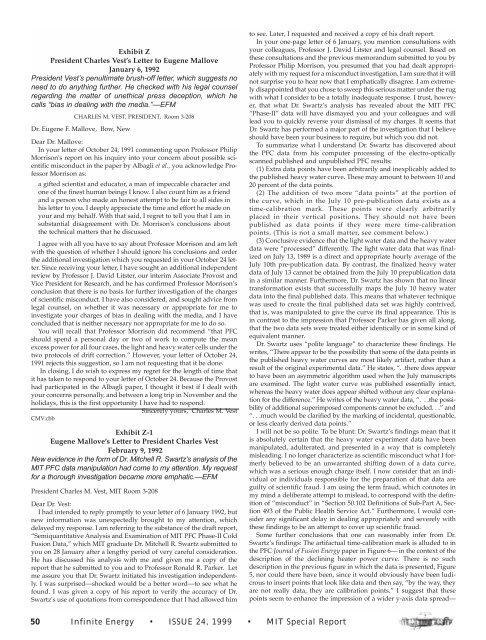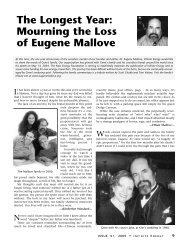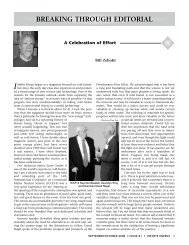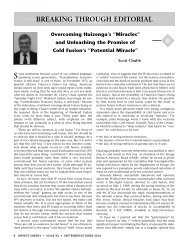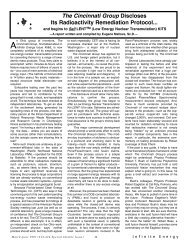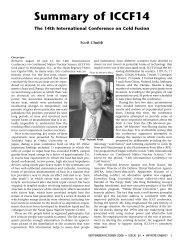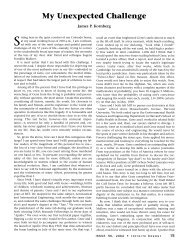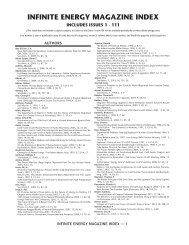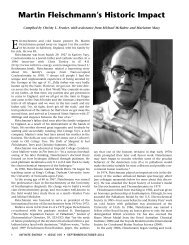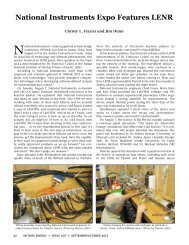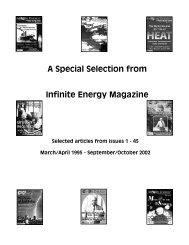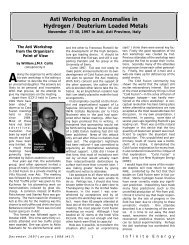MIT and Cold Fusion: A Special Report - Infinite Energy Magazine
MIT and Cold Fusion: A Special Report - Infinite Energy Magazine
MIT and Cold Fusion: A Special Report - Infinite Energy Magazine
You also want an ePaper? Increase the reach of your titles
YUMPU automatically turns print PDFs into web optimized ePapers that Google loves.
Exhibit Z<br />
President Charles Vest’s Letter to Eugene Mallove<br />
January 6, 1992<br />
President Vest’s penultimate brush-off letter, which suggests no<br />
need to do anything further. He checked with his legal counsel<br />
regarding the matter of unethical press deception, which he<br />
calls “bias in dealing with the media.”—EFM<br />
CHARLES M. VEST, PRESIDENT, Room 3-208<br />
Dr. Eugene F. Mallove, Bow, New<br />
Dear Dr. Mallove:<br />
In your letter of October 24, 1991 commenting upon Professor Philip<br />
Morrison's report on his inquiry into your concern about possible scientific<br />
misconduct in the paper by Albagli et al., you acknowledge Professor<br />
Morrison as:<br />
a gifted scientist <strong>and</strong> educator, a man of impeccable character <strong>and</strong><br />
one of the finest human beings I know. I also count him as a friend<br />
<strong>and</strong> a person who made an honest attempt to be fair to all sides in<br />
his letter to you. I deeply appreciate the time <strong>and</strong> effort he made on<br />
your <strong>and</strong> my behalf. With that said, I regret to tell you that I am in<br />
substantial disagreement with Dr. Morrison's conclusions about<br />
the technical matters that he discussed.<br />
I agree with all you have to say about Professor Morrison <strong>and</strong> am left<br />
with the question of whether I should ignore his conclusions <strong>and</strong> order<br />
the additional investigation which you requested in your October 24 letter.<br />
Since receiving your letter, I have sought an additional independent<br />
review by Professor J. David Litster, our interim Associate Provost <strong>and</strong><br />
Vice President for Research, <strong>and</strong> he has confirmed Professor Morrison’s<br />
conclusion that there is no basis for further investigation of the charges<br />
of scientific misconduct. I have also considered, <strong>and</strong> sought advice from<br />
legal counsel, on whether it was necessary or appropriate for me to<br />
investigate your charges of bias in dealing with the media, <strong>and</strong> I have<br />
concluded that is neither necessary nor appropriate for me to do so.<br />
You will recall that Professor Morrison did recommend “that PFC<br />
should spend a personal day or two of work to compute the mean<br />
excess power for all four cases, the light <strong>and</strong> heavy water cells under the<br />
two protocols of drift correction.” However, your letter of October 24,<br />
1991 rejects this suggestion, so I am not requesting that it be done.<br />
In closing, I do wish to express my regret for the length of time that<br />
it has taken to respond to your letter of October 24. Because the Provost<br />
had participated in the Albagli paper, I thought it best if I dealt with<br />
your concerns personally, <strong>and</strong> between a long trip in November <strong>and</strong> the<br />
holidays, this is the first opportunity I have had to respond.<br />
Sincerely yours, Charles M. Vest<br />
CMV:cbb<br />
Exhibit Z-1<br />
Eugene Mallove’s Letter to President Charles Vest<br />
February 9, 1992<br />
New evidence in the form of Dr. Mitchell R. Swartz’s analysis of the<br />
<strong>MIT</strong> PFC data manipulation had come to my attention. My request<br />
for a thorough investigation became more emphatic.—EFM<br />
President Charles M. Vest, <strong>MIT</strong> Room 3-208<br />
Dear Dr. Vest:<br />
I had intended to reply promptly to your letter of 6 January 1992, but<br />
new information was unexpectedly brought to my attention, which<br />
delayed my response. I am referring to the substance of the draft report,<br />
“Semiquantitative Analysis <strong>and</strong> Examination of <strong>MIT</strong> PFC Phase-II <strong>Cold</strong><br />
<strong>Fusion</strong> Data,” which <strong>MIT</strong> graduate Dr. Mitchell R. Swartz submitted to<br />
you on 28 January after a lengthy period of very careful consideration.<br />
He has discussed his analysis with me <strong>and</strong> given me a copy of the<br />
report that he submitted to you <strong>and</strong> to Professor Ronald R. Parker. Let<br />
me assure you that Dr. Swartz initiated his investigation independently.<br />
I was surprised—shocked would be a better word—to see what he<br />
found. I was given a copy of his report to verify the accuracy of Dr.<br />
Swartz's use of quotations from correspondence that I had allowed him<br />
to see. Later, I requested <strong>and</strong> received a copy of his draft report.<br />
In your one-page letter of 6 January, you mention consultations with<br />
your colleagues, Professor J. David Litster <strong>and</strong> legal counsel. Based on<br />
these consultations <strong>and</strong> the previous memor<strong>and</strong>um submitted to you by<br />
Professor Philip Morrison, you presumed that you had dealt appropriately<br />
with my request for a misconduct investigation. I am sure that it will<br />
not surprise you to hear now that I emphatically disagree. I am extremely<br />
disappointed that you chose to sweep this serious matter under the rug<br />
with what I consider to be a totally inadequate response. I trust, however,<br />
that what Dr. Swartz’s analysis has revealed about the <strong>MIT</strong> PFC<br />
“Phase-II” data will have dismayed you <strong>and</strong> your colleagues <strong>and</strong> will<br />
lead you to quickly reverse your dismissal of my charges. It seems that<br />
Dr. Swartz has performed a major part of the investigation that I believe<br />
should have been your business to require, but which you did not.<br />
To summarize what I underst<strong>and</strong> Dr. Swartz has discovered about<br />
the PFC data from his computer processing of the electro-optically<br />
scanned published <strong>and</strong> unpublished PFC results:<br />
(1) Extra data points have been arbitrarily <strong>and</strong> inexplicably added to<br />
the published heavy water curve. These may amount to between 10 <strong>and</strong><br />
20 percent of the data points.<br />
(2) The addition of two more “data points” at the portion of<br />
the curve, which in the July 10 pre-publication data exists as a<br />
time-calibration mark. These points were clearly arbitrarily<br />
placed in their vertical positions. They should not have been<br />
published as data points if they were mere time-calibration<br />
points. (This is not a small matter, see comment below.)<br />
(3) Conclusive evidence that the light water data <strong>and</strong> the heavy water<br />
data were “processed” differently. The light water data that was finalized<br />
on July 13, 1989 is a direct <strong>and</strong> appropriate hourly average of the<br />
July 10th pre-publication data. By contrast, the finalized heavy water<br />
data of July 13 cannot be obtained from the July 10 prepublication data<br />
in a similar manner. Furthermore, Dr. Swartz has shown that no linear<br />
transformation exists that successfully maps the July 10 heavy water<br />
data into the final published data. This means that whatever technique<br />
was used to create the final published data set was highly contrived,<br />
that is, was manipulated to give the curve its final appearance. This is<br />
in contrast to the impression that Professor Parker has given all along,<br />
that the two data sets were treated either identically or in some kind of<br />
equivalent manner.<br />
Dr. Swartz uses “polite language” to characterize these findings. He<br />
writes, “There appear to be the possibility that some of the data points in<br />
the published heavy water curves are most likely artifact, rather than a<br />
result of the original experimental data.” He states, “. .there does appear<br />
to have been an asymmetric algorithm used when the July manuscripts<br />
are examined. The light water curve was published essentially intact,<br />
whereas the heavy water does appear shifted without any clear explanation<br />
for the difference.” He writes of the heavy water data, “. . .the possibility<br />
of additional superimposed components cannot be excluded. . .” <strong>and</strong><br />
“. . .much would be clarified by the marking of incidental, questionable,<br />
or less clearly derived data points.”<br />
I will not be so polite. To be blunt: Dr. Swartz’s findings mean that it<br />
is absolutely certain that the heavy water experiment data have been<br />
manipulated, adulterated, <strong>and</strong> presented in a way that is completely<br />
misleading. I no longer characterize as scientific misconduct what I formerly<br />
believed to be an unwarranted shifting down of a data curve,<br />
which was a serious enough charge itself. I now consider that an individual<br />
or individuals responsible for the preparation of that data are<br />
guilty of scientific fraud. I am using the term fraud, which connotes in<br />
my mind a deliberate attempt to mislead, to correspond with the definition<br />
of “misconduct” in “Section 50.102 Definitions of Sub-Part A, Section<br />
493 of the Public Health Service Act.” Furthermore, I would consider<br />
any significant delay in dealing appropriately <strong>and</strong> severely with<br />
these findings to be an attempt to cover up scientific fraud.<br />
Some further conclusions that one can reasonably infer from Dr.<br />
Swartz’s findings: The artifactual time-calibration mark is alluded to in<br />
the PFC Journal of <strong>Fusion</strong> <strong>Energy</strong> paper in Figure 6— in the context of the<br />
description of the declining heater power curve. There is no such<br />
description in the previous figure in which the data is presented, Figure<br />
5, nor could there have been, since it would obviously have been ludicrous<br />
to insert points that look like data <strong>and</strong> then say, “by the way, they<br />
are not really data, they are calibration points.” I suggest that these<br />
points seem to enhance the impression of a wider y-axis data spread—<br />
50 <strong>Infinite</strong> <strong>Energy</strong> • ISSUE 24, 1999 • <strong>MIT</strong> <strong>Special</strong> <strong>Report</strong>


